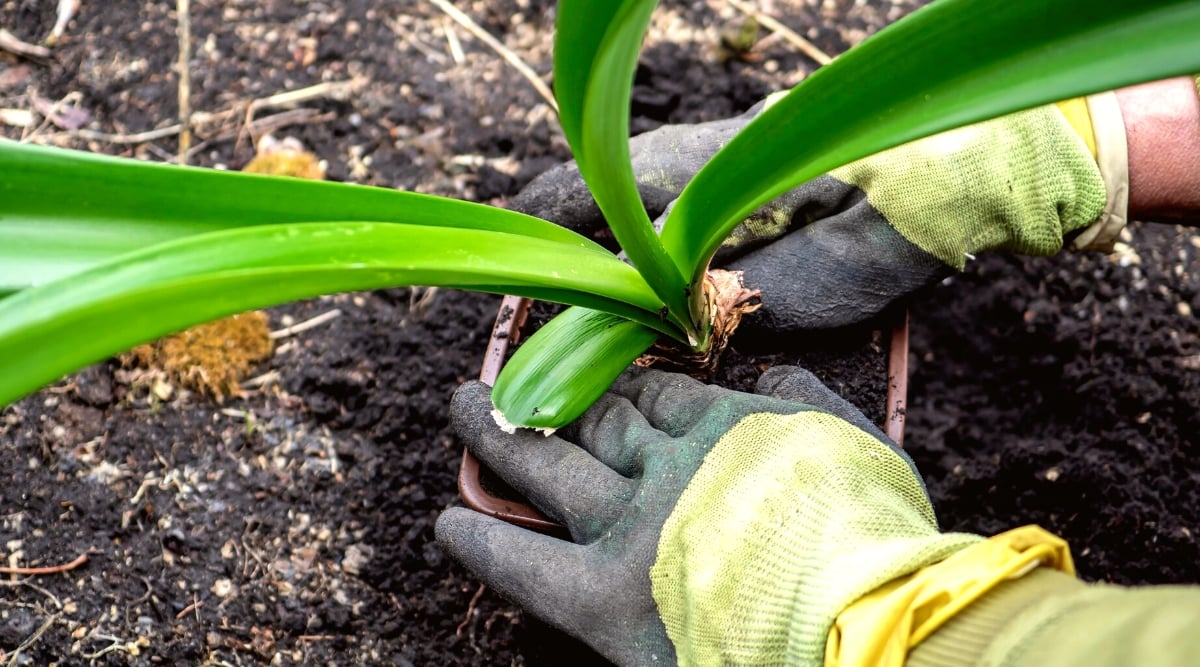With large, bold blooms in varied colors, amaryllis makes a gorgeous garden or houseplant addition. Its single, double, and even miniature bloom varieties offer clusters of trumpet blooms that grace the garden and can be forced to bloom indoors.
Popular during holidays, this bulb is a beautiful plant to gift and receive. Potted bulbs and kits are readily available in stores, catalogs, and garden centers, making this easy-care houseplant a striking addition to the winter season.
If your amaryllis bulb isn’t blooming, don’t despair. It’s normal for bulbs to experience different growth and flower production periods. With the best cultural practices, your plant will recover for future blooms.
The Short Answer
A few cultural requirements are essential in encouraging an amaryllis bulb to bloom. Reasons for not blooming are often related to water, light, and/or temperature – the primary conditions needed to initiate blooming. Take care to provide adequate water when the soil surface feels dry, about once a week. Keep the plant in a bright, warm, sunny spot indoors. For reblooming in following years, the bulb must experience an annual 8-12 week chill cycle at temperatures of 50-55℉.
The Long Answer
If an amaryllis is not blooming, check on a few growing conditions first:
- Is the plant location too cool? This may inhibit flowering.
- Is it getting sunlight? It may not have enough light exposure to create energy through photosynthesis in leaves and stems.
- What about water – is the plant getting too much or too little?
- Did the bulb have a cool time? The bulb may not have met its chill requirement in the previous season.
For new bulbs, look to light, water, and temperature and adjust as needed to initiate flowering quickly. To encourage future blooms, follow proper cultural practices to get the bulb to bloom annually. We’ll review these best practices below.
New Bulbs
Plant your purchased bulbs and provide proper exposure, drainage, and care for quick blooming indoors.
Purchased bulbs have sometimes been exposed to a period of chill by the grower and are ready to produce new leaves and blooms quickly. They will bloom within four to six weeks of planting in the right conditions.
To ensure blooming, plant bulbs with ⅓ of the bulb exposed above the soil line. Use a container one inch larger than the bulb – amaryllis likes to be a little crowded in the pot. Make sure the pot and soil mix have good drainage.
Water newly planted bulbs thoroughly with tepid or room temperature water. Place them on a sunny windowsill, with a south-facing exposure as the best choice. Plants need regular water when the soil surface starts to dry out (generally about once a week). Touch the surface and probe just below it to check for moisture. Fertilize with a liquid solution every two to four weeks.
Ideal growing temperatures to foster indoor blooms are 65-70℉. When in flower, slightly cooler temperatures (60-65℉) can prolong bloom time.
Encouraging Rebloom
 Extend your plant’s life by growing indoors or combining indoor/outdoor care.
Extend your plant’s life by growing indoors or combining indoor/outdoor care.
To extend the life and enjoyment of your bulb beyond the holidays, grow it year-round as a houseplant or employ a combination of indoor/outdoor growing. Amaryllis bloom once annually, with a natural bloom time of late spring or early summer, or can bloom indoors at other times of the year by forcing. Either way, the bulbs need a period of chill time to bloom in successive years.
Bulbs also need time to store energy for reblooming in the next growing season. Ensure they receive enough light, keep leaves in place for photosynthesis until they are naturally yellow, and fertilize in spring and summer. In the next season, bulbs use these carbohydrate reserves to grow new leaves and flowers.
Care After Initial Bloom
 Trim spent blooms to keep them from going to seed and keep the leaves for energy.
Trim spent blooms to keep them from going to seed and keep the leaves for energy.
After the amaryllis bulb has finished flowering, remove spent blooms to keep them from going to seed. The stem will continue to photosynthesize; cut it with pruners or a sharp knife when it starts to yellow and wither. Cut one to two inches above the bulb. Keep the long, strappy leaves intact, as they are essential to creating and storing energy for future growth.
Keep the plant in a sunny indoor spot until after the final spring frost, when it can be moved outside. Water as usual when the soil surface is nearly dry. Use a balanced liquid fertilizer once or twice monthly to promote energy storage.
Bring the plant back inside when temperatures drop in the fall, especially before the first frost of the cool season.
Chill Requirements and Dormancy
 For annual amaryllis blooms, try exposing bulbs to 50-55℉ for 8-10 weeks to encourage growth.
For annual amaryllis blooms, try exposing bulbs to 50-55℉ for 8-10 weeks to encourage growth.
While amaryllis bulbs do not require dormancy to rebloom, they do require a cooling period. Inducing dormancy is necessary when forcing amaryllis to bloom (say, at holiday time) annually.
Amaryllis bulbs must be exposed to temperatures of 50-55℉ for a minimum of eight to ten weeks, and there are two ways to achieve this. The first is to maintain the amaryllis as a green plant from fall to early mid-winter if you have the right spot. Place the plant in a well-lit location in the ideal cooling temperature range – can be 40-55℉ – for eight to twelve weeks. After the chill requirement is met, move the plant to a warmer 70-75℉ spot and water thoroughly to encourage the growing and blooming cycle.
Another option is to induce dormancy and provide a cooling period throughout. If you want blooms in time for the holidays, count backward eight to ten weeks and begin dormancy in the fall (late September is a good time). Place the plant in a cool, semi-dark location and withhold water. Cut off leaves as they brown naturally. Keep the bulb in the 40-55℉ chill range for at least eight to ten weeks. After this period, move the bulb to its sunny indoor location for warmth and watering, where it begins actively growing and blooming again.
Waxed Bulbs
 Waxed amaryllis bulbs make great gifts but are usually a single-time bloomer.
Waxed amaryllis bulbs make great gifts but are usually a single-time bloomer.
Decorative waxed amaryllis bulbs make excellent gifts as they are easy to grow and require no water. The bulbs utilize stored carbohydrates to produce flowers. These waxed amaryllis are intended to be single-use rather than saving for year-round growth, but if you do choose to save and grow, there are a few care conditions to follow.
Once the flower stalk fades, carefully remove the wax from the bulb. Take care not to damage small roots emerging from the bulb’s base. Because the bulb used its stored energy, it will have shrunk in size. Toss the bulb if it has dark, soft, or sunken spots – signs of disease.
Pot up the bulb as usual and follow regular care guidelines. The bulb may rebloom or may take a couple of seasons to recover and rebuild in size.
Growing Amaryllis in the Garden
 In zones 8-10, you can plant amaryllis outdoors.
In zones 8-10, you can plant amaryllis outdoors.
Grow amaryllis indoors year-round or move plants outside in the spring after the threat of final frost. Potted amaryllis takes about a week to acclimate, so gradually harden it off. Place the plant outside in a shady, protected area for the first two to three days. Gradually expose the pot to longer periods of direct sunlight. After seven to ten days, place the amaryllis in a full-to-part sun spot on the patio or in the garden. You can also bury the pot for an in-ground, planted look.
Continue to water when dry, and fertilize once or twice monthly through summer. Stop fertilizing in late summer (July is a good timeframe) as active growing slows. Bring amaryllis indoors or to its chill location before frosty fall temperatures arrive.
In USDA zones 8-10, plant amaryllis directly in the ground for year-round growth. Provide a thick layer of mulch in winter, or keep it in containers to bring indoors during cold temperatures. Outdoors, amaryllis will continue to grow and revert to its original bloom cycle.
Final Thoughts
Amaryllis makes gorgeous, long-lasting houseplants and garden bloomers. While amaryllis is easy to grow, achieving blooms beyond the first year takes some care. Following the best cultural practices for amaryllis isn’t technical; in fact, it’s very achievable!
Ensure amaryllis have a chill period during the cool season (indoors or out). Grant exposure to a warm, sunny growing location. Keep the soil moist and well-drained, and use a balanced liquid fertilizer during the active growing and flowering season.
These growing practices will give your amaryllis the best chance to produce the outrageously colorful blooms for which it’s known. Don’t hesitate to keep your amaryllis beyond the holiday season and let it become your latest garden or interiorscape addition.



